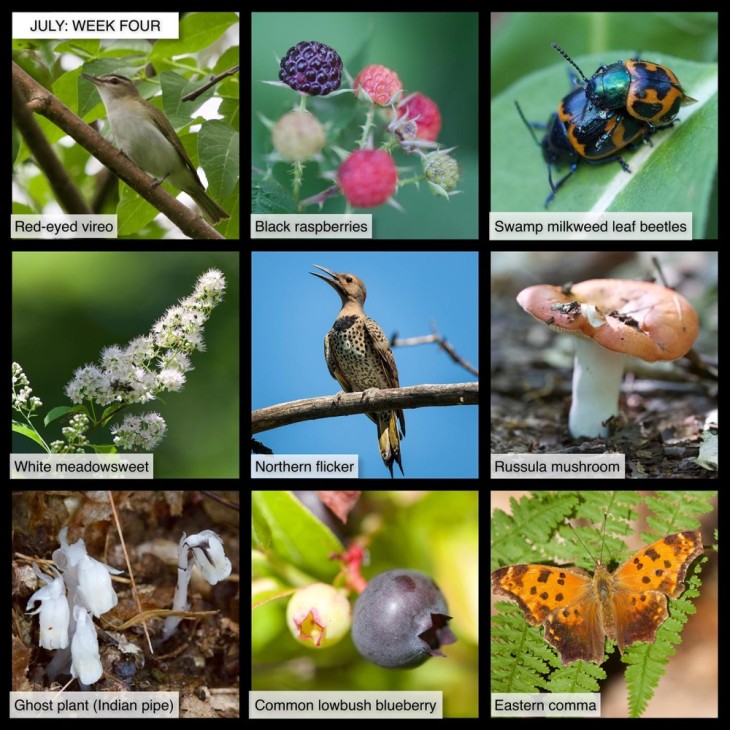This week in the woods, we’ve had several close encounters with red-eyed vireo fledglings and adults. Common summer residents of deciduous woodlands, red-eyed vireos are hard to see but easy to hear. The male’s call – Here I am. Where are you? – is persistent. According to this Cornell Lab profile, a single bird may call over 20,000 times in one day. Here’s a New Hampshire Audubon YouTube video from this month, showing an adult sitting in its birch bark-lined, cup-shaped nest.
Flowering raspberries are big but not very sweet. Red raspberries are super sweet, but their fruit tends to fall apart when it’s picked, especially after a rain. Blackberries won’t, for the most part, be ripe for another couple of weeks. Fortunately, there’s black raspberry, which is ripe now, very sweet, and excellent with ice cream. Here’s a species profile from The Native Plant Trust.
If you find a milkweed leaf that has been “skeletonized” into network of white strands, you’re probably looking at the work of a swamp milkweed leaf beetle. These big, iridescent beetles are mating right now, and we’ve also found some of their orange larvae. The University of Wisconsin Milwaukee’s “Bug Lady” has a comprehensive write-up on the species, including a note about its cannibalistic tendencies. In common with many other milkweed feeders that absorb the plant’s toxins, the beetles have bright coloring to warn off predators, and feeding strategies to minimize their exposure to milkweed’s super sticky latex.
White meadowsweet is blooming now. Its cone-shaped clusters of tiny white flowers appeal to a diversity of pollinators; they’re often covered with tiny flies and bees. The plant grows both in the sun and shady edges, but it prefers damp soil; we find it in abundance along seeps in fields. Here’s a profile from the Lady Bird Johnson Wildflower Center, including more images of its fuzzy-looking flowers.
Northern flicker fledglings are also out and about, and complaining loudly to their parents. You may see them up in the trees, but they’re also hide out together on the ground. If you step too close, they’ll burst up into the air– making a similar flight sound as a startled grouse. Although, like other woodpeckers, flickers nest in tree holes and other cavities, they spend a fair amount of their time on the ground, hunting ants and other insects. Check out this Outside Story essay by Madeline Bodin, and for a major dose of cuteness, see this 2012 Vermont Institute of Natural Science YouTube video of an intern caring for ten very hungry flicker fledglings.
If you find a large mushroom with a white stem and plain (no flecks) red cap, the odds are good that you’re looking at a species from the genus Russula. A tell for this mushroom type is that, because of its specialized cell structure, it tends to shatter. Ben Hoffman, writing for the Cornell Mushroom Blog, suggested this means of identification: “Throw it at something (a tree, the ground, a friend) and watch for its explosion into little pieces. This is satisfying because it confirms the brittle nature of the mushroom while at the same time reducing the risk that you will attempt to identify it [by species], a process sure to end in tears.” Note: despite the meaning of the Latin name, not all russulas are red. And despite the presence of some species in foraging references, edible and poisonous russulas can look awfully similar.
Want another indicator that you’re in the presence of a russula? Look around and see if there’s a ghost plant (also called Indian pipe) growing nearby. This weird little plant doesn’t have chlorophyll; instead it parasitizes Russula and Lactarius genus fungi by siphoning nutrients from their mycelia (aka underground network of filaments, akin to plants’ roots). Here’s an essay by Edna Greig (with a beautiful image by photographer Jim Block), and here’s a profile from Adirondacks Forever Wild.
There are several species of wild blueberry producing fruit right now. The one you’re most likely to encounter is common lowbush blueberry. This often grows in ground-hugging, clonal patches connected through a root system – you may find it, for example, on a hillside meadow, or cliff edge. Here’s a U.S. Forest Service profile, noting the plant’s wildlife value.
Although bright orange eastern comma butterflies sometimes show up on field edges, you’re more likely to find them along trails or haunting a sunny patch of ferns in the woods. The summer brood of this insect is now flying, distinguished from its winter version by its shaded hind wings. We have observed them chasing other butterflies, which fits with this description from Massachusetts Audubon: “Eastern commas are territorial and pugnacious and will fly at any butterflies or other large insects that ‘invade’ the sunny patches serving as their territories.” There are other, similar-looking species of comma butterflies; one way to sort them out is by the specific shape of the tiny white mark on their outer (underside) hind wing. This is the “comma” that gives the butterfly group its name.
In this difficult period, many of us find joy in observing local nature, and many families are seeking outdoor enrichment opportunities for children. Here are nine photographs taken this past week, most within 15 miles of the Northern Woodlands office in Lyme, New Hampshire. We hope you enjoy using this grid as a prompt for your own explorations, or as the basis for a game of family forest tic-tac-toe.
What are you seeing in the woods this week? Share your images with us on Facebook, or submit a special photo for possible inclusion in our monthly online Reader Photo Gallery.


